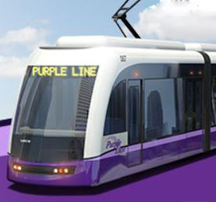Power Point presentation from June 9 ACT meeting with Nat Bottigheimer & Matthew Ridgway of Fehr & Peers
"What Montgomery County's Growth Policy Can Learn from California”
Land Use
The Action Committee for Transit has a vision of a Montgomery County where it is easier to travel and more pleasant to live — a county built for people and not for automobiles.
Years of overreliance on the automobile have created an environment of suburban sprawl in our county and throughout the region. We have the ugliness of Tysons Corner and Rockville Pike instead of hometowns where we can take Metro to work, do errands on foot, and meet our neighbors in the street.
Transit is a key to fixing these problems, but adding more transit will not automatically create the kind of neighborhoods we want. Our land use policies also need to change. Tract housing, strip malls, and office parks must give way to transit- and pedestrian-oriented communities in which land uses are harmoniously mixed.
In the last two decades, the county has tried to encourage clustered development around Metro stations, but these efforts have achieved only partial success. Sprawl development continues in much of the county, and even near the Metro stations we have too many sterile suburban towers and too few lively urban streetscapes. Much of the blame for this situation must be assigned to the rules imposed by Montgomery County's zoning ordinance, its Master Plans, and the so-called “Growth Policy,” which still often reflect the failed sprawl-creating theories of the 1950s.
The Growth Policy is a failed attempt to prevent traffic congestion by building roads. It incentivizes developers to build more roads by tying new development to the level of congestion at nearby intersections. The consequence is often to favor scattered development that consumes more land and requires more and longer car trips, and in the end makes traffic congestion worse rather than better. ACT and its allies call for a fundamentally different policy that incentivizes developers to produce less traffic rather than more roads.
The zoning ordinance is based on the long-discredited concept that different land uses need to be separated from each other. The county began to move away from this idea decades ago. But rather than repealing harmful laws, we kept them on the books and used master plans to counteract their bad effects. At last, an effort has now begun to rewrite the zoning code. ACT's analysis of the fundamental flaws of the current zoning ordinance is here.
The old zoning code's minimum parking requirements are an enormous obstacle to good land use. The proposed modifications will help, but they fall far short of what is needed. ACT calls for complete repeal of these rules.
In addition to promoting transit-oriented development by seeking changes in land use rules, ACT supports worthwhile development projects near Metro stations and opposes plans that promote sprawl. Land-use issues on which ACT has taken positions include these:
Bethesda Naval Hospital expansion (BRAC)
Affordable housing
Parking at affordable housing
Big box stores
Woodmont Triangle
Woodmont East
Shady Grove and Twinbrook
Glenmont

